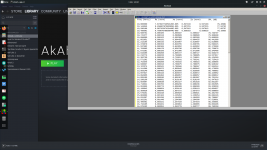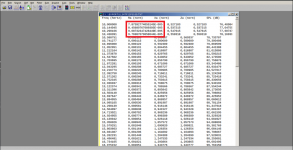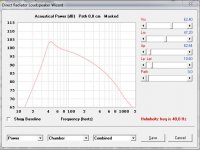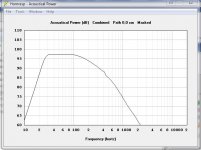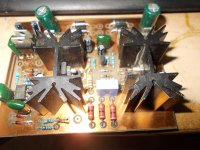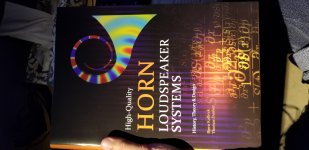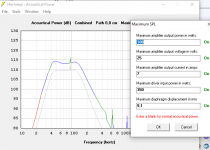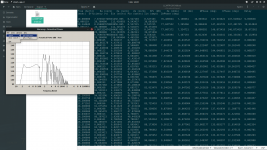
Exporting data does not seem to be a problem at least.
I have only used Hornresp in Proton for an hour or so, but I was amazed by the simplicity of installing it and running it. There was always some struggle under Wine, even though I got it to work once in a while.
Can steam proton run on android phones?
I would guess no. They run ARM processors. I don't think Proton runs on ARM at all.
Not that it really matters, but as far as Hornresp is concerned, even for very small or very large numbers, all exported values should be formatted simply to 6 decimal places (ie. scientific / engineering notation not used). In the example you show, for some reason the normalised Ra values for the first 4 frequencies are formatted to more than 6 decimal places, using scientific notation.Exporting data does not seem to be a problem at least.
Attachments
Can I ask, why Exporting Rectangular Horn - Why is the width is / 2 and the height is /2
I am making a simple midrange horn. Parabolic horn exported with Conical flare to keep straight edges. The S1 is smaller than the Sd and I want a simple flare.
Thank you. The app is amazing.
Much appreciated.
I am making a simple midrange horn. Parabolic horn exported with Conical flare to keep straight edges. The S1 is smaller than the Sd and I want a simple flare.
Thank you. The app is amazing.
Much appreciated.
Hello David,
Is it possible to construct a waveguide where the first half of its length is OSWG and the second half is a Le Cléac'h horn in Hornresp? While I am not aware of any special benefits of such a construction or even if the math involved allows for such a thing, I ask out of curiosity.
Dr. Geddes recommends rounding off the edges of a OSWG, and Le Cléac'h geometry has a nice and smooth natural rounding off to the back at the end, inherent to its math. So, I wondered if it's possible to use it to round off an OSWG's end.
Apologies in advance if this doesn't make any sense
Is it possible to construct a waveguide where the first half of its length is OSWG and the second half is a Le Cléac'h horn in Hornresp? While I am not aware of any special benefits of such a construction or even if the math involved allows for such a thing, I ask out of curiosity.
Dr. Geddes recommends rounding off the edges of a OSWG, and Le Cléac'h geometry has a nice and smooth natural rounding off to the back at the end, inherent to its math. So, I wondered if it's possible to use it to round off an OSWG's end.
Apologies in advance if this doesn't make any sense
Why is the width is / 2 and the height is /2.
Hi Andypk,
Just to make it easier for you when marking out mould / mold templates, or side panels.
Process:
1. Draw the template / panel centre line.
2. Mark the length distances along the centre line.
3. At those distance points draw lines at right angles to the centre line either side of it using a set square / triangle.
4. Mark the half-width or half-height points on the right angle lines, either side of the centre line.
5. Connect the dots on either side to generate the required template / panel profile.
Kind regards,
David
Is it possible to construct a waveguide where the first half of its length is OSWG and the second half is a Le Cléac'h horn in Hornresp?
Hi Giri,
Sorry, no.
Kind regards,
David
Why not?
The mouth of th first becomes the throat of the second. At that point you match slope and radius of curvature. WHGHello David,
Is it possible to construct a waveguide where the first half of its length is OSWG and the second half is a Le Cléac'h horn in Hornresp? While I am not aware of any special benefits of such a construction or even if the math involved allows for such a thing, I ask out of curiosity.
Dr. Geddes recommends rounding off the edges of a OSWG, and Le Cléac'h geometry has a nice and smooth natural rounding off to the back at the end, inherent to its math. So, I wondered if it's possible to use it to round off an OSWG's end.
Apologies in advance if this doesn't make any sense
LeCleach produces continuous diffraction. It is going to happen anyway, LeCleach does it well.I am not aware of any special benefits of such a construction
At the mouth, not in the OS neck.
Any curve of increasing curvature that is a candidate for horn lip formation will have this characteristic. You cannot mitigate entirely wave diffraction at the mouth of a finite horn. Mouth lips will simply reduce it and the LeCleach method may be successfully used for this purpose. WHG
LeCleach produces continuous diffraction. It is going to happen anyway, LeCleach does it well.
Any curve of increasing curvature that is a candidate for horn lip formation will have this characteristic. You cannot mitigate entirely wave diffraction at the mouth of a finite horn. Mouth lips will simply reduce it and the LeCleach method may be successfully used for this purpose. WHG
Indeed, and you don't hear much about HOM in LeCleach horn throats.At the mouth, not in the OS neck.
Why not?
Hi Bill,
If you attempt to match the mouth and throat sizes, the slope and the radius of curvature of the two flare profiles using Hornresp, I think you will quickly discover why not... 🙂.
Kind regards,
David
Hi Kees,
If you are referring to a down-firing closed-box woofer, then it is not really possible to simulate such a system in Hornresp.
Kind regards,
David
Hi David. Using the normal closed box calculation works fine for downfiring types. i have meaure the resonance and it is 5 hz higher then with hornresp calculation, what is normal because also the speaker still new and not played in well so it is quite precise.
In a old book I did see the hemlholtz frequency has to be tuned to this resonance including speaker I have in that closed box, doing so I get a big peak. but make the tuning lower hornresp give me a nice graph. Is that oke.
I have now ready the speaker measurement jigg, it is not for hornresp itselfs and out of discussion here but worth mention about it, contains class B 5 watt amp and buffers, so I have a trustable measurement. Can put that in a separate tread
Have a nice day.
regards
Attachments
Last edited:
Look what showed up at my doorstep
Cover corners are smashed and a crestant shaped indent on the cover.
Amazon knows better than to ship a book in this manner, especially if across the pond. Sadly to replace will take at least three weeks, unless I order another then it will take two. Amazon doesnt actually have the book, took them 4 business days to receive.
Cover corners are smashed and a crestant shaped indent on the cover.
Amazon knows better than to ship a book in this manner, especially if across the pond. Sadly to replace will take at least three weeks, unless I order another then it will take two. Amazon doesnt actually have the book, took them 4 business days to receive.
Attachments
Hi all, it appears the Max SPL tool doesn't take in to effect the filters set in the Filter Wizard.
Is this correct?
Or is there a way to get filters to work with Max SPL that I might be missing?
Thanks!
Is this correct?
Or is there a way to get filters to work with Max SPL that I might be missing?
Thanks!
As I understand it, MaxSPL is the max_power(freq) subject to a short list of constraints irrespective of filter settings. Best thing to do with filters set is increase power until you hit the excursion limit and then look at the "driver power" screen to see if you have exceeded driver or amplifier power limits.
As I understand it, MaxSPL is the max_power(freq) subject to a short list of constraints irrespective of filter settings. Best thing to do with filters set is increase power until you hit the excursion limit and then look at the "driver power" screen to see if you have exceeded driver or amplifier power limits.
Gotcha, makes sense. Thanks🙂
Max SPL at 1 frequency point doesn't depend of filter. It depend of the capabilities settings you gives in Max SPL screen.Hi all, it appears the Max SPL tool doesn't take in to effect the filters set in the Filter Wizard.
Is this correct?
Or is there a way to get filters to work with Max SPL that I might be missing?
Thanks!
In the shown design, whatever i do with the set of constraint i put, colors gives me the max SPL i can reach before being limited. I used Tool=> compare previous, to see if with the input voltage i set i main input screen i would be limited. It is in grey. It appears i have a really good margin of 8-15db before reaching some of the limit i set using the voltage i plan to use. And filter was active in grey curve.
Attachments
Last edited:
That's Unfortunate.
As doing this is the preferred way to design a multi-segment horn that minimizes wave diffraction. Of course the segments may be formed by other functions as well. WHG
Hi Bill,
If you attempt to match the mouth and throat sizes, the slope and the radius of curvature of the two flare profiles using Hornresp, I think you will quickly discover why not... 🙂.
Kind regards,
David
As doing this is the preferred way to design a multi-segment horn that minimizes wave diffraction. Of course the segments may be formed by other functions as well. WHG
- Home
- Loudspeakers
- Subwoofers
- Hornresp
